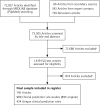Developing an international register of clinical prediction rules for use in primary care: a descriptive analysis
- PMID: 25024245
- PMCID: PMC4096474
- DOI: 10.1370/afm.1640
Developing an international register of clinical prediction rules for use in primary care: a descriptive analysis
Abstract
Purpose: We describe the methodology used to create a register of clinical prediction rules relevant to primary care. We also summarize the rules included in the register according to various characteristics.
Methods: To identify relevant articles, we searched the MEDLINE database (PubMed) for the years 1980 to 2009 and supplemented the results with searches of secondary sources (books on clinical prediction rules) and personal resources (eg, experts in the field). The rules described in relevant articles were classified according to their clinical domain, the stage of development, and the clinical setting in which they were studied.
Results: Our search identified clinical prediction rules reported between 1965 and 2009. The largest share of rules (37.2%) were retrieved from PubMed. The number of published rules increased substantially over the study decades. We included 745 articles in the register; many contained more than 1 clinical prediction rule study (eg, both a derivation study and a validation study), resulting in 989 individual studies. In all, 434 unique rules had gone through derivation; however, only 54.8% had been validated and merely 2.8% had undergone analysis of their impact on either the process or outcome of clinical care. The rules most commonly pertained to cardiovascular disease, respiratory, and musculoskeletal conditions. They had most often been studied in the primary care or emergency department settings.
Conclusions: Many clinical prediction rules have been derived, but only about half have been validated and few have been assessed for clinical impact. This lack of thorough evaluation for many rules makes it difficult to retrieve and identify those that are ready for use at the point of patient care. We plan to develop an international web-based register of clinical prediction rules and computer-based clinical decision support systems.
Keywords: clinical decision support systems; clinical prediction rule; decision aid; decision making; primary care; score card.
© 2014 Annals of Family Medicine, Inc.
Figures



References
-
- McGinn TG, Guyatt GH, Wyer PC, Naylor CD, Stiell IG, Richardson WS; Evidence-Based Medicine Working Group. Users’ guides to the medical literature: XXII: how to use articles about clinical decision rules. JAMA. 2000;284(1):79–84 - PubMed
-
- Grobman WA, Stamilio DM. Methods of clinical prediction. Am J Obstet Gynecol. 2006;194(3):888–894 - PubMed
-
- Adams ST, Leveson SH. Clinical prediction rules. BMJ. 2012;344: d8312. - PubMed
-
- Centor RM, Witherspoon JM, Dalton HP, Brody CE, Link K. The diagnosis of strep throat in adults in the emergency room. Med Decis Making. 1981;1(3):239–246 - PubMed
-
- Johnston SC, Rothwell PM, Nguyen-Huynh MN, et al. Validation and refinement of scores to predict very early stroke risk after transient ischaemic attack. Lancet. 2007;369(9558):283–292 - PubMed
Publication types
MeSH terms
LinkOut - more resources
Full Text Sources
Other Literature Sources
